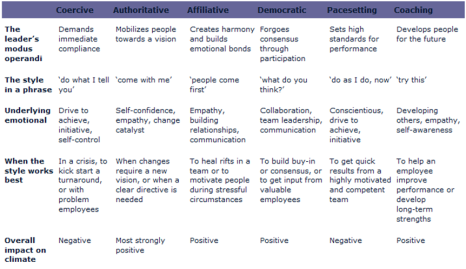In order to lead a team successfully, effective management approach and managers’ personal styles have been long examined. A growing consensus of opinion on this issue is that managers will need to adopt various leadership styles as the best approach will be different depending on circumstances and individual characteristics (CMI 2013).
This blog explores this point of view by using theories and an example from an organisation in comparison with my own experience of being managed.
Understanding of working with a group and individual motivation
It will be useful for managers to acquire knowledge about working with a group and individual motivation.
Every group has its own colour. To assess individuals’ behaviour and roles in a team will give a clue to leaders how to make their teams best worked (Belbin 1993). In addition, Tuckman and Jensen (1977) mention that there are stages of group development and groups gradually form and evolve through different stages. A pattern of members’ behaviour and a stage of group development will influence to a group character.
On the other hand, individuals’ motivation is another important facto or manages to consider. Research shows that motivating individuals are more committed to the workplace and can improve efficiency and quality for a company’s business (The Times n.d.). Therefore, to understand what motivates individuals and keep employees motivated are important as those staff members are companies’ assets and will bring benefits to organisations.
Example from an organisation
The characteristics of groups and motivation of individuals vary. Moreover, an organisation’s working circumstance will change over time. From this point, different styles of leadership need to be used so as to manage subordinates. Leadership styles will change whether a group faces with crisis, changes, team buildings or performance improvement.
In ‘Leadership that gets results’, Goleman (2000) explores emotional intelligence in relate to leadership development and success in organisations. Table 1 shows that Goleman’s six leadership styles and the theory outlines measurable effects on a different working circumstance.
Table 1: The six leadership styles at a glance (Goleman 2000:82-83).
Besides, the author uses an example of Joan who works for a global food and beverage company to illustrate the effectiveness of using different leadership styles.
When Joan was newly appointed as the general manager for a deep troubled division, she actively communicated with key people during her first week and then, decided to employ ‘Democratic’ leadership that will create harmony and build band in the team. For example, she regularly had off-site meetings that everybody in the team could freely express their complaints or concerns. On the following day, she made the team focused on finding solutions. Meanwhile, Joan also applied ‘Coaching’ style as she had noticed potential in her team members. Especially, she helped her team members to achieve their career goals by giving private feedback.
The other styles that Joan used were ‘Authoritative’ and ‘Coercive’. She used both leadership styles when the group needed to achieve goals under its new vision. The former style will be particularly useful when a clear direction is required in course of changes. In fact, Joan urgently needed to change the group since the division had suffered underperformance records for the past six years. This background made her to employ the ‘Coercive’ style that will be effective to turn a crisis situation into a shift.
Joan switched different leadership styles according to a circumstance of her group and this management approach resulted in success. Her group had become more motivated and started to take initiative to achieve the organisation vision.
My own experience by being managed by different leadership styles
From my experience, there is some truth in Goleman’s leadership styles. Similar to other industries, the airline industry values team work since no single flight operation does exist without other divisions’ cooperation. This is probably a reason why many managers have employed ‘Affiliative’ or/and ‘Democratic’ styles of leadership in this industry.
It cannot be denied those leadership styles are effective especially when a process of building a team or enhancing communication among members. Yet, those styles will not function when a group enters in a crisis situation. In that case, employees are likely to seek for more strong leadership such as ‘Coercive’ and ‘Authoritative’.
Conclusions – The benefits and limitations of situational leadership
Goleman (2000) concludes that leaders need four or more, particularly ‘Authoritative’, ‘Affiliative’, ‘Democratic’ and ‘Coaching’, leadership styles. However, in reality, most managers would have only one or two styles. To master different styles and switch them flexibly would not be easy and this will be on-going learning processes.
Today, leaders are required to respond to continually changing business environments; indeed, most effective leaders switch their styles timely according to the situation. To master different styles of leadership and practise the best approach will be utterly challenging. Yet, the efforts and leaders’ persistence will be reflected in results of their team performance.
(767 words)


Although there are many theories about management styles, but I think there do not has only one theory can apply to to any kind of situation. So manager needs to find out a method which is the most suitable way for the existing situation.
Yes, I agree with you. There may be not right and wrong answers. And even managers and leaders will need to keep learning to seek what the best way to lead people.
yes, I agree with you, thanks your reply
Max Chen, thank you for sharing your thoughts with me.